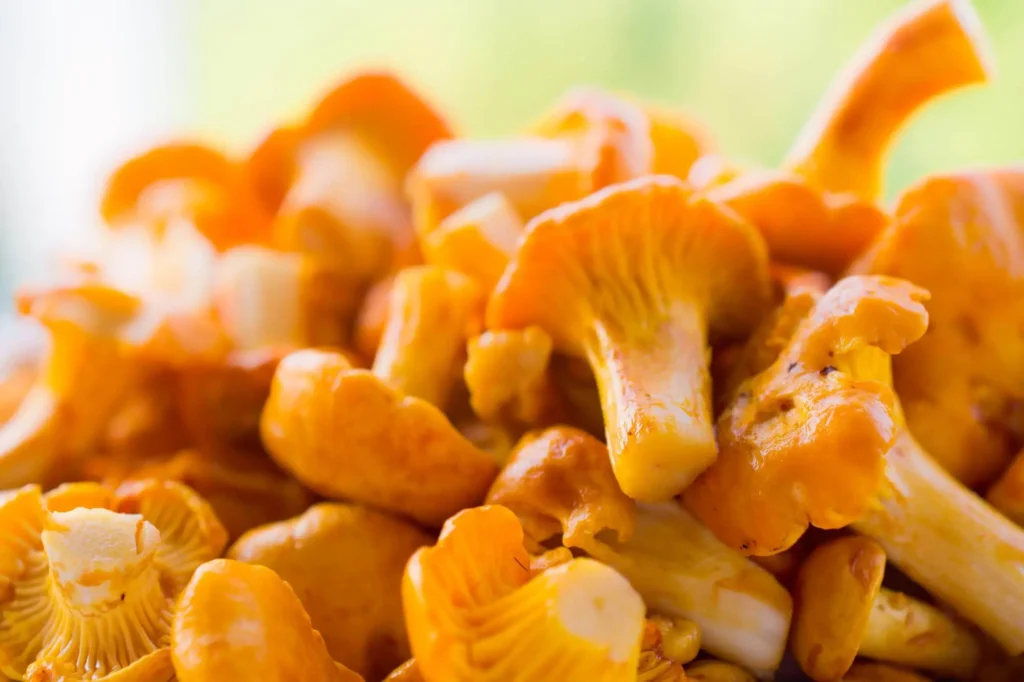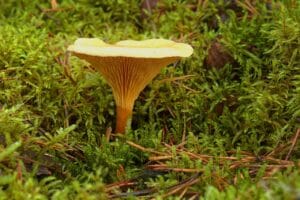
Get the Best Meals Recipes
Recognizing Chanterelle Mushrooms: A Visual Guide

Chanterelle mushrooms are a big deal in cooking and foraging. They’re loved for their unique taste. Knowing how to spot them is key, especially since some mushrooms look alike and can be dangerous.
This guide will help you learn to identify chanterelle mushrooms. It focuses on how to tell them apart visually. By understanding their unique features, you’ll be better prepared for foraging adventures.

What are Chanterelle Mushrooms?
Chanterelle mushrooms are part of the Cantharellus genus. They are loved for their taste and unique flavors. Knowing the different types of chanterelles helps in identifying them correctly. Each type has its own look and way of growing. Cantharellus cibarius is known for its golden color and fruity smell. Cantharellus tubaeformis has a longer shape and a peppery taste.
Overview of Chanterelle Varieties
Chanterelles come in many varieties, leading to interesting discussions about identifying them. Color, size, and texture help tell them apart.
For example, Cantharellus cibarius likes moist places, while Cantharellus tubaeformis grows in acidic soils. This variety difference makes foraging more exciting. It lets people enjoy the different tastes of chanterelles.
Habitat and Growth Conditions
Chanterelles prefer forests, especially those with conifers and deciduous trees. They live in harmony with tree roots, trading nutrients for growth. They need well-drained soil, steady moisture, and the right temperature to grow.
Knowing these conditions helps foragers find chanterelles. It ensures they can gather these mushrooms in a way that’s good for the environment.
Key Characteristics for Chanterelle Identification
To identify chanterelle mushrooms, you need to know their unique features. Look closely at their cap shape and color. Also, pay attention to the mushroom gills, aroma, and taste. These details help you tell them apart.
Cap Shape and Color
The chanterelle cap looks like a trumpet. It comes in bright yellows and deep oranges. This makes them stand out in the forest.
The color can change based on the species and where they grow.
Gills and Stem Features
Chanterelle mushrooms have special gills. They are not like other fungi’s gills. Instead, they are forked and go down the stem a bit.
The stem is firm and fleshy. It might be the same color as the cap. This helps identify it as a chanterelle.
Distinct Aroma and Taste
Chanterelles have a unique smell and taste. They smell fruity, with a hint of pepper. It’s like apricots.
Knowing these smells and tastes helps you find them. It makes sure you know what you’re picking.
Similar Species: Avoiding Confusion
In the world of mushroom hunting, it’s key to know the chanterelle look-alikes. Many mushrooms look like chanterelles, which can lead to mistakes. Being careful when identifying mushrooms helps avoid eating something harmful.
Look-Alikes: Risky Mushrooms to Identify
The false chanterelle (Hygrophoropsis aurantiaca) and the jack-o’-lantern mushroom (Omphalotus olearius) are common mistakes. They look similar to chanterelles, making them tricky for beginners.
Key Differences in Appearance
To tell true chanterelles from look-alikes, look at their details. The table below shows key differences to help identify mushrooms.
Characteristic | True Chanterelle | False Chanterelle | Jack-O’-Lantern |
|---|---|---|---|
Cap Color | Golden yellow | Orange to brown | Bright orange |
Gill Structure | Forked, wavy gills | Non-forked, closely spaced | True gills, not forked |
Habitat | Deciduous and coniferous forests | Forest floors, often near conifers | Decaying wood and forest debris |
Edibility | Edible | Non-toxic but not recommended | Toxic |
Knowing these differences helps mushroom hunters avoid mistakes. Always be careful when picking mushrooms to make sure they’re safe to eat.
Chanterelle Identification Tips for Foragers
Identifying chanterelle mushrooms needs knowledge and a focus on safe foraging. Foragers use established methods and tools. These help in accurate identification, safety, and caring for the environment.
Best Practices for Safe Foraging
Safe foraging is key when searching for chanterelles. Here are some tips:
- Learn from experienced foragers through workshops or field trips.
- Use reputable field guides for accurat identification info.
- Forage in groups for a collaborative learning space .
- Know local laws and regulations about mushroom gathering.
- Respect habitats and ecosystems for environmental stewardship.
Essential Tools for Identification
Many mushroom identification tools can help foragers find chanterelles. Here are some:
- Digital cameras for high-quality images to check later.
- Foraging baskets to collect specimens without harm.
- Field guides with detailed illustrations and descriptions for on-field help.
- Smartphone apps for mushroom identification.
Conclusion
This article has covered key points about chanterelle mushrooms. We’ve looked at their shape, colors, and smells. Knowing these details is crucial for anyone who loves to forage for mushrooms.
It’s also important to know how to forage safely. Misidentifying mushrooms can be dangerous. So, learning about mushrooms is key.
Foraging for mushrooms should be done with care and knowledge. By understanding chanterelles, we can forage safely and enjoy our finds. This knowledge helps us all to forage better and more responsibly.